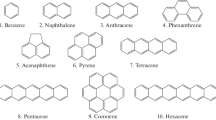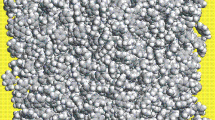Conclusions
-
1.
Molecular mechanics in the MM/2 parametrization and quantum-chemical calculations with the geometry optimized by molecular mechanics accurately describe the thermochemistry, geometric structure, and electronic structure of spiro hydrocarbons containing three-and four-membered rings.
-
2.
According to the data from the calculations, the linking of small rings by means of spiro atoms to five-and six-carbon rings, including the construction of [5]-and [6]-rotane, is not associated with additional stressing of the original molecule or significant straining of the valence bonds.
-
3.
The successive linking of several (up to four) three-carbon rings by means of spiro atoms is accompanied by the additive accumulation of additional destabilization amounting to 8–10 kcal/mole for each spiro atom, the C-C bonds lying opposite to the spiro atoms being weakened, and the adjacent bonds being strengthened.
Similar content being viewed by others
Literature cited
V. A. Svyatkin, A. I. Ioffe, and O. M. Nefedov, Izv. Akad. Nauk SSSR, Ser. Khim., 1578 (1985).
A. Greenberg and J. F. Liebman, Strained Organic Molecules, Academic Press, New York (1978).
M. P. Kozina, V. S. Mastryukova, and E. M. Mil'vitskaya, Usp. Khim.,51, 1337 (1982).
N. L. Allinger, J. Am. Chem. Soc.,99, 8127 (1977).
A. I. Ioffe, V. A. Svyatkin, and O. M. Nefedov, Izv. Akad. Nauk SSSR, Ser. Khim., 1060 (1985).
S. W. Benson, Thermochemical Kinetics, Wiley, New York (1968).
J. B. Fedley and J. Rylance, Computer-Analyzed Thermochemical Data: Organic and Organometallic Compounds, University of Sussex (1977).
R. Gleiter, Topics in Current Chemistry,86, 197 (1979).
G. Dullinga, D. R. van der Diaai, and L. N. Toneman, Rec. Trav. Chim.,87, 897 (1968).
T. Prange, C. Pascerd, A. de Meiere, U. Behrens, J.-P. Barnier, and J. M. Conia, Nouv. J. Chim.,4, 321 (1980).
A. Almeningen, O. Bastiansen, B. N. Cyvin, S. Cyvin, L. Fernholt, and C. Rφmming, Acta Chem. Scand.,A38, 31 (1984).
P. George, M. Trachtman, C. W. Bock, and A. M. Brett, Tetrahedron,32, 317 (1976).
H. Fisher and H. Kollmar, Theor. Chim. Acta,16, 163 (1970).
J. M. Denis, C. Girard, and J. M. Conia, Synthesis, 549 (1972).
L. Fitjer and L. M. Conia, Angew Chem., Int. Ed.,12, 761 (1973).
Author information
Authors and Affiliations
Additional information
For report 3 see [1].
Translated from Izvestiya Akademii Nauk SSSR, No. 4, pp. 801–807, April, 1987.
We express our thanks to Prof. M. Jones (Princeton University, U.S.A.) and Prof. P. B. von Schleyer (Institute of Organic Chemistry at the University of Erlangen, West Germany) for their cooperation in obtaining the MM/2 program, Prof. L. V. Gurvich (Institute of High Temperatures, Academy of Sciences of the USSR) and Prof. J. B. Fedley (University of Sussex, Great Britain) for allowing us to become familiar with the latest version of the data base of thermodynamic parameters [11], and V. I. Faustov for supplying the MINDO/3 program.
Rights and permissions
About this article
Cite this article
Ioffe, A.I., Svyatkin, V.A. & Nefedov, O.M. Molecular-mechanical analysis of the structure of stressed organic molecules. 4. Spiro hydrocarbons. Russ Chem Bull 36, 727–733 (1987). https://doi.org/10.1007/BF00962309
Received:
Issue Date:
DOI: https://doi.org/10.1007/BF00962309




